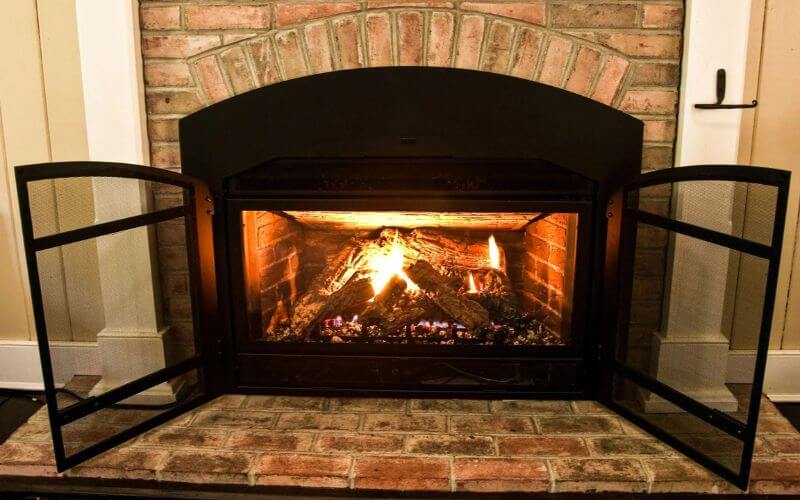Gas fireplaces outperform traditional wood-burning fireplaces in terms of security and user control. Thermostats can also control these heating systems. If you’re considering installing a thermostat for your gas fireplace, you might wonder if you need a specific type. We researched to provide you with the answer.
No, gas fireplaces are versatile and can be controlled by thermostats, switches, or remotes. However, if you want to use a thermostat to control your gas fireplace, the millivolt type is best due to its ease of installation and overall functionality.
Table of Contents
ToggleYou already know that a millivolt thermostat is ideal for a gas fireplace, but you can use any type you have. Installing and adjusting the thermostat connected to the gas fireplace may be necessary. For more information, continue reading.
Also check: Do Natural Gas Furnaces Have A Pilot Light?
What Is the Best Type of Gas Fireplace Thermostat?
Millivolts is the best thermostat for a gas fireplace. This thermostat operates on low voltage. As a result, it is simple to install and use in gas fireplaces. It does not require a step-down transformer or to be connected to the house’s leading power.
Despite its simplicity, the Millivolt thermostat contains all of the simple settings. They are available in the form of digitally programmable smart thermostats.
Is the Nest Thermostat compatible with gas fireplaces?
Yes, the Nest Thermostat works with gas fireplaces and is a millivolt system. It is so simple to set up and use.
Installing a Gas Fireplace Thermostat
Installing a millivolt thermostat in a gas fireplace is a relatively simple task for homeowners. These instructions will walk you through installing a millivolt thermostat on your gas fireplace, including your Nest. Before you begin, make sure you have the following supplies.
Supplies
Other HVAC systems, such as central heating and cooling, accept 24VAC, but gas fireplaces do not. As a result, you must be a little creative. You can purchase a transformer at your local hardware store. You can use this attachment to convert your thermostat to 24V AC power.
The next item you’ll need to purchase is a fan relay. This enables the use of millivolt systems on gas fireplaces. A female spade connector will also come in handy for this task. These items are required to ensure that your gas fireplace and thermostat are properly connected.
Instructions
- The thermostat can be connected to the fireplace once the purchase is complete. Locate and disconnect the existing thermostat wire first. If desired, the electricity in the area can also be turned off. Electrical work carries an inherent risk of injury.
- The power supply will be installed next. Connect to the appropriate points and route all cables to the thermostat unit’s back plate. Connect the AC adapter cable to the terminal on the temperature control unit’s right side. Tin this lead’s ends.
- The other power wire should be connected to the red thermostat wire. Finally, connect the white thermostat wire to the thermostat unit’s W1 terminal. The power and thermostat units were connected at this point.
- The fan relay must connect the gas fireplace and the thermostat unit. Locate the thermostat wire inside the chimney and insert spade connectors into two of them, his and hers from the thermostat assembly.
- Connect the thermostat unit’s wires to relay terminals 1 and 3. Then connect the wires from the fireplace thermostat to relay terminals two and four. Now that everything is connected put your work to the test.
- Connect the thermostat unit to the backplate after turning on the power and plugging in the adapter. Turn on the gas fireplace using the thermostat.
When properly installed, the thermostat will signal the fireplace to turn on and off. If not, you must deal with and repair the insecure connection.
How Do You Turn On A Gas Fireplace Thermostat?
Once your thermostat has been properly installed, you may wish to learn how to adjust your gas fireplace for maximum comfort and convenience.
Turn on the heat: There are two options: temperature or timer. We’ll walk you through each method.
By temperature: Temperature Mode regulates your gas fireplace by sensing the temperature of the air around you and sending signals to the gas fireplace to either heat or cool the space. This is an excellent option for using a fireplace as a heat source during the cold winter.
The steps for setting the thermostat to temperature mode differ slightly for millivolt thermostats, but they are based on the Nest thermostat. To begin, press the “Settings” button. You will be given the option to select Sun mode. This may be “Temp” mode on other thermostats. Then adjust the temperature to your preference.
Then, after 5-10 seconds, either wait for the thermostat to finish programming or press the OFF button. That’s all!
By Timer: When the thermostat is set to timer mode, it instructs the gas fireplace to turn on at one time and turn off at another.
While you might enjoy a cozy fireplace for a few hours in the evening, you probably don’t want to put it out before falling asleep on the couch or going to bed.
To set the thermostat to timer mode, press the SET button. This will bring up the options for choosing the “timer” mode. When you press the set button again, you will be prompted to select a start time. When you press the button again, you will be prompted to choose an end time.
Also check: How Much Does It Cost To Run An Electric Furnace?
Install The Gas Fireplace With Special Thermostat Yourself!
Gas fireplaces are versatile in many ways, including control methods. A thermostat can be used with a gas fireplace, but a millivolt thermostat is preferred—these aid gas fireplaces in providing warmth and ambiance to your home during the winter.





















